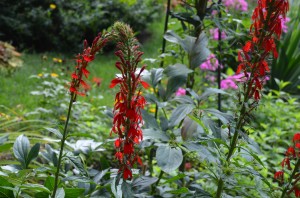With their vibrant red colored blooms in July and August and a strong vertical growth habit, you visually can’t miss with our native cardinal flowers (Lobelia cardinalis) (USDA hardiness zones 3-9). Hummingbirds and butterflies won’t pass them by either.
Cardinal flowers are also called scarlet lobelias. Their vibrant red single raceme flowers single them out from other summer-flowering perennials. The non-branching flower stalks are covered from top to bottom with small flowers. In the garden blooms can be present from early to late summer, particularly if you keep them deadheaded. In the wild, they tend to bloom 3-4 weeks later if moisture is adequate.
Cardinal flowers prefer a compost-rich moist site in full sun. Mulching is highly recommended for even soil moisture. Set plants 2 to 3 feet apart. You may also opt to submerge pots of cardinal flower in a water garden, plant them in a rain garden, or on the edge of a stream or lake. Periodic flooding makes it look better; again, roots crave soil moist.
This clump-forming perennial has no serious pest or disease problems. Deer seem to leave it alone. It is best divided after three years in early spring. There are several cultivars available including the popular red, pink and white. Some of them include ‘Alba’ (white blooms), ‘Heather Pink’ (pink) and a ‘Black Truffle’ (dark chocolaty-purple foliage and bold red flowers). Black Truffle’s dark foliage holds throughout the spring and summer months.
L. cardinalis serves a parent in the breeding of new hybrid lobelias. Some of the hybrid forms may not be as hardy as cardinal flower itself.


 Posted in
Posted in 
